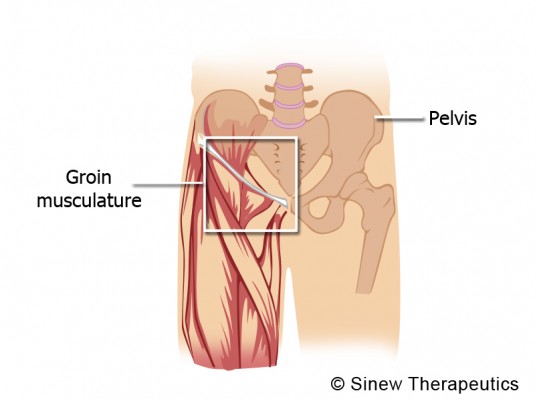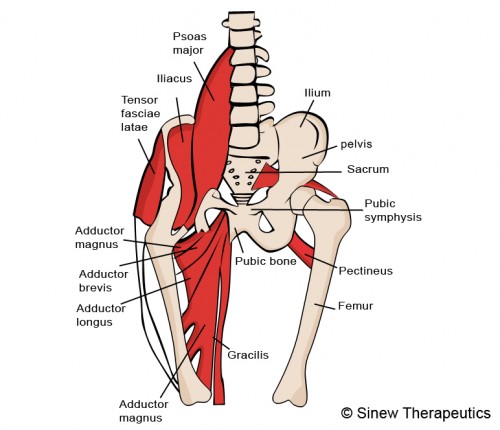Gilmore’s groin is a medical condition that affects the groin and abdominal region. It’s also commonly referred to as a sports hernia, athletic pubalgia, hockey hernia, groin disruption, or the sportsman’s hernia. The term sports hernia is beloved by the media, mainly due to number of high-profile professional athletes suffering from the injury in recent years. However, referring to the injury as a “hernia” often leads to confusion. It’s important to clarify that there isn’t an actual hernia involved, therefore referring to the syndrome as a hernia is a misnomer.


Gilmore's Groin
What Is Gilmore’s Groin?
Gilmore’s groin is a common muscular-tendon injury affecting athletes. It’s characterized by chronic groin and/or abdominal pain and a dilated superficial ring of the inguinal canal. Many in sports medicine refer to Gilmore's groin as a "hidden hernia," meaning there is lower abdominal and groin pain, but no visible lumps or bumps associated with a hernia.
What Causes Gilmore’s Groin?
The injury takes place at the junction where the torso and leg meet. Specifically, the injury involves the area around the inguinal canal. The aponeurosis is a fibrous sheet that resembles a flattened tendon. It’s where the internal oblique, transversus abdominus, and external oblique (abdominal muscles) converge to form the inguinal ligament. A tear to the external oblique aponeurosis is one of the most often seen injuries in Gilmore’s groin. Other tears may involve a number of structures, including the following:
* tear in the fascia transversalis
* tear in the conjoint tendon (the common tendon of the transverse and internal oblique muscles)
* tearing of the conjoint tendon from pubic tubercle
* dehiscence between inguinal ligament and conjoined tendon
* tearing of the abdominal internal oblique muscle from the pubic tubercle
* labral tears of the hip
Muscle strength imbalances and/or weak abdominal muscles may also contribute to damaging the tissues surrounding the inguinal canal. For example, strong and tight hip flexors often tilt the pelvis forward and stretch and tear abdominal obliques, especially if already weakened.
Sports, especially football, soccer, hockey, and rugby, place a great deal of repetitive stress and strain on the pelvic and groin area. Gilmore’s groin is most often attributed to the shearing force created by frequent long-term adduction, abduction, extension, and flexion movements involved in certain sports.
What Are The Symptoms Of Gilmore’s Groin?
* groin and/or abdominal pain
* pain that increases with hip extension and turning and twisting movements
* pain may increase when the legs are squeezed together or when trying to rise from a supine or seated position
* pain may radiate laterally to the adductor muscle and testicles
* stiffness and soreness after training or play
* pain, stiffness, and soreness usually dissipates with rest and returns with exercise
* groin/ abdominal pain upon coughing or sneezing
* a true hernia (outwardly bulging area) will not be found on X-ray, seen with the naked eye, or be physically palpable
Strengthening Exercises
These Groin Exercises are ideal to build strength and flexibility.
Massage Treatment
These Groin Massage Techniques are of great value in pain relief; circulation stimulation; dispersing blood and fluid accumulations; swelling reduction; and relaxing muscle spasms, especially when used alongside the Sinew Therapeutics liniments and soaks.
ACUTE STAGE SYMPTOMS AND TREATMENT
This stage is characterized by swelling, redness, pain, and possibly a local sensation of heat, indicating inflammation. If coolness makes your pain feel better, then the Acute Stage Treatment is recommended.
ACUTE STAGE SYMPTOMS:
The acute stage starts the moment an injury occurs and lasts until the swelling and inflammation are gone. The swelling is the result of the blockage of blood, tissue fluids and circulation in the groin because their normal movement has been disrupted by the force of the injury. Just like cars back up behind a traffic jam, causing congestion, exhaust and overheating; blood and fluids back up behind the injured groin, causing pain, inflammation, lumps and swelling.
The sensation of heat is due to the warming action of the blood and fluids overheating in the injured groin as they back up and accumulate. Stiffness and decreased mobility are due to spasms in tendons and ligaments that have contracted reflexively beyond their normal range from the impact of the injury.
As ligaments and tendons stretch and tear, blood from ruptured blood vessels becomes trapped in the local tissues. As the trapped blood clots up, it sticks the tissues together creating adhesions. Adhesions cause pain, inflammation and restricted movement because the layers of tissue that used to slide smoothly across one another now adhere and snap which interferes with normal functioning. It is essential to break up clotted blood as quickly as possible to prevent adhesions and scar tissue from forming.
During the acute stage it is very important to restore normal circulation to the groin, break up clotted blood and stagnant fluids, reduce swelling, and reduce the redness and heat associated with inflammation. By restoring the flow of blood, fluids, and circulation in the groin, then pain is relieved, damaged tissues can regenerate with healthy functional tissue, and the groin can strengthen and regain it's mobility.
ACUTE STAGE TREATMENT:
1. Apply the Sinew Herbal Ice on your groin to reduce redness, swelling, and inflammation while dispersing accumulated blood and fluids to help restore normal circulation to the groin. This first-aid treatment is used in place of ice to significantly speed up the healing process. It reduces the swelling and inflammation more effectively than ice, allowing you to more quickly regain range of motion. Acute Sinew Liniment can be used in-between applications.
Ice is not recommended because it does not help repair damaged tissues and keeps everything in the injured area frozen, causing the stagnation of blood and fluids and the contraction of muscles, tendons and ligaments. In Chinese sports medicine ice is not used and is considered a culprit in injuries that donít heal well.
2. Massage your groin with Acute Sinew Liniment to relieve pain, reduce swelling and inflammation, break up clotted blood and stagnant fluids, and stimulate circulation of blood and fluids to help cells quickly repair damaged tissues. Sinew Herbal Ice can be used in-between applications.
3. The Sinew Sports Massage Oil is recommended for use before and after exercise, sports and strenuous activity. It warms and stimulates your muscles, increases circulation and relieves tightness, hence improving your performance and helping to prevent injury.
CHRONIC STAGE SYMPTOMS AND TREATMENT
This stage begins once the swelling and inflammation are gone, but you still feel pain, stiffness, weakness, and/or sensitivity in cold and damp weather. If heat makes your pain feel better, then the Chronic Stage Treatment is recommended.
CHRONIC STAGE SYMPTOMS:
The chronic stage begins once the swelling and inflammation are gone, but you still feel aching pain and stiffness. This is because there are still accumulations of stagnant blood and fluids in your groin that are blocking circulation and blood supply to damaged tissues, creating residual pain, stiffness and weakness. You may actually feel hard nodules like sand in the tissue, indicating accumulation, calcification, and adhesions, which all cause pain, stiffness, and joint instability.
Your groin may feel more sensitive to the cold and ache in cold and damp weather due to impaired circulation. These symptoms are often the result of failure to treat the injury properly from the outset and overicing.
Increasing circulation and blood supply to the damaged tissues is very important in treating chronic injuries because tendons and ligaments do not have an extensive direct supply of blood. That is why chronic injuries can be slow to heal. Increasing local circulation also prevents cold and dampness from penetrating the injured area, preventing pain and stiffness.
During the chronic stage it is very important to break up remaining accumulations of blood and fluids, and increase circulation and blood supply to the damaged tissues. By increasing circulation and blood flow in the groin, then pain and stiffness is relieved, and the damaged tissues can strengthen to restore stability.
CHRONIC STAGE TREATMENT:
1. Massage your groin with Chronic Sinew Liniment to relieve pain and stiffness, strongly stimulate circulation and blood flow to damaged tissues, and promote the healing of overstretched tendons and ligaments. The Sinew Relaxing Soak can be used in-between applications.
2. Soak your groin with the Sinew Relaxing Soak to relax muscles and tendons that are in spasm, ease joint pain and stiffness, and improve range of motion. The Sinew Relaxing Soak is particularly useful if you feel spasms in your groin. The soak can be used by saturating a towel in the liquid and applying it to your groin. Chronic Sinew Liniment can be used in-between applications.
3. The Sinew Sports Massage Oil is recommended for use before and after exercise, sports and strenuous activity. It warms and stimulates your muscles, increases circulation and relieves tightness, hence improving your performance and helping to prevent injury.







